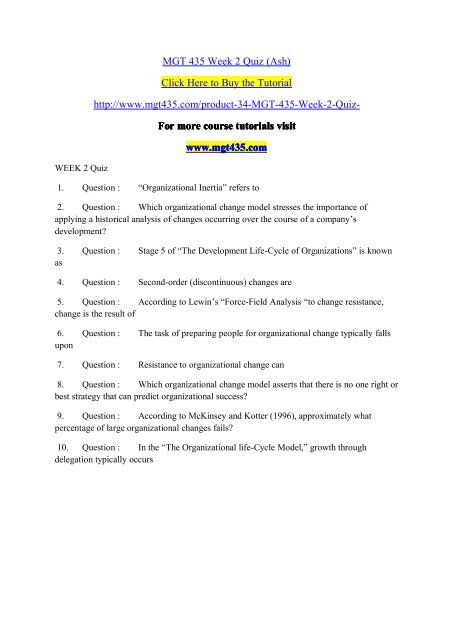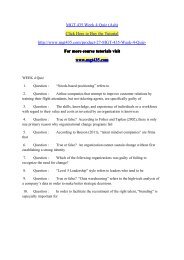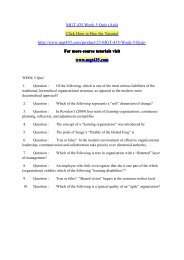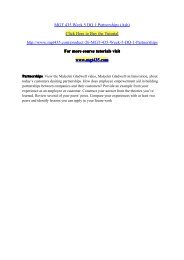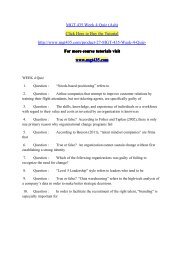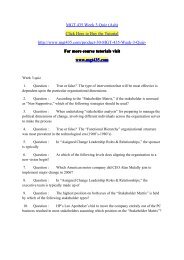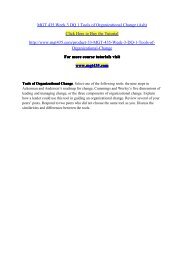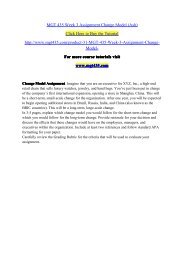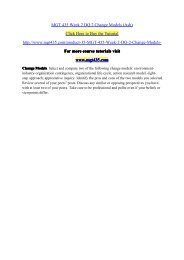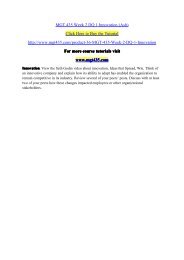MGT 435 Week 2 Quiz (Ash)
For more course tutorials visit www.mgt435.com WEEK 2 Quiz 1. Question : “Organizational Inertia” refers to 2. Question : Which organizational change model stresses the importance of applying a historical analysis of changes occurring over the course of a company’s development? 3. Question : Stage 5 of “The Development Life-Cycle of Organizations” is known as 4. Question : Second-order (discontinuous) changes are 5. Question : According to Lewin’s “Force-Field Analysis “to change resistance, change is the result of 6. Question : The task of preparing people for organizational change typically falls upon 7. Question : Resistance to organizational change can 8. Question : Which organizational change model asserts that there is no one right or best strategy that can predict organizational success? 9. Question : According to McKinsey and Kotter (1996), approximately what percentage of large organizational changes fails? 10. Question : In the “The Organizational life-Cycle Model,” growth through delegation typically occurs
For more course tutorials visit
www.mgt435.com
WEEK 2 Quiz
1. Question : “Organizational Inertia” refers to
2. Question : Which organizational change model stresses the importance of applying a historical analysis of changes occurring over the course of a company’s development?
3. Question : Stage 5 of “The Development Life-Cycle of Organizations” is known as
4. Question : Second-order (discontinuous) changes are
5. Question : According to Lewin’s “Force-Field Analysis “to change resistance, change is the result of
6. Question : The task of preparing people for organizational change typically falls upon
7. Question : Resistance to organizational change can
8. Question : Which organizational change model asserts that there is no one right or best strategy that can predict organizational success?
9. Question : According to McKinsey and Kotter (1996), approximately what percentage of large organizational changes fails?
10. Question : In the “The Organizational life-Cycle Model,” growth through delegation typically occurs
- No tags were found...
Create successful ePaper yourself
Turn your PDF publications into a flip-book with our unique Google optimized e-Paper software.
WEEK 2 <strong>Quiz</strong><br />
<strong>MGT</strong> <strong>435</strong> <strong>Week</strong> 2 <strong>Quiz</strong> (<strong>Ash</strong>)<br />
Click Here to Buy the Tutorial<br />
http://www.mgt<strong>435</strong>.com/product-34-<strong>MGT</strong>-<strong>435</strong>-<strong>Week</strong>-2-<strong>Quiz</strong>-<br />
For more course tutorials visit<br />
www.mgt<strong>435</strong><br />
mgt<strong>435</strong>.com<br />
1. Question : “Organizational Inertia” refers to<br />
2. Question : Which organizational change model stresses the importance of<br />
applying a historical analysis of changes occurring over the course of a company’s<br />
development?<br />
3. Question : Stage 5 of “The Development Life-Cycle of Organizations” is known<br />
as<br />
4. Question : Second-order (discontinuous) changes are<br />
5. Question : According to Lewin’s “Force-Field Analysis “to change resistance,<br />
change is the result of<br />
6. Question : The task of preparing people for organizational change typically falls<br />
upon<br />
7. Question : Resistance to organizational change can<br />
8. Question : Which organizational change model asserts that there is no one right or<br />
best strategy that can predict organizational success?<br />
9. Question : According to McKinsey and Kotter (1996), approximately what<br />
percentage of large organizational changes fails?<br />
10. Question : In the “The Organizational life-Cycle Model,” growth through<br />
delegation typically occurs


